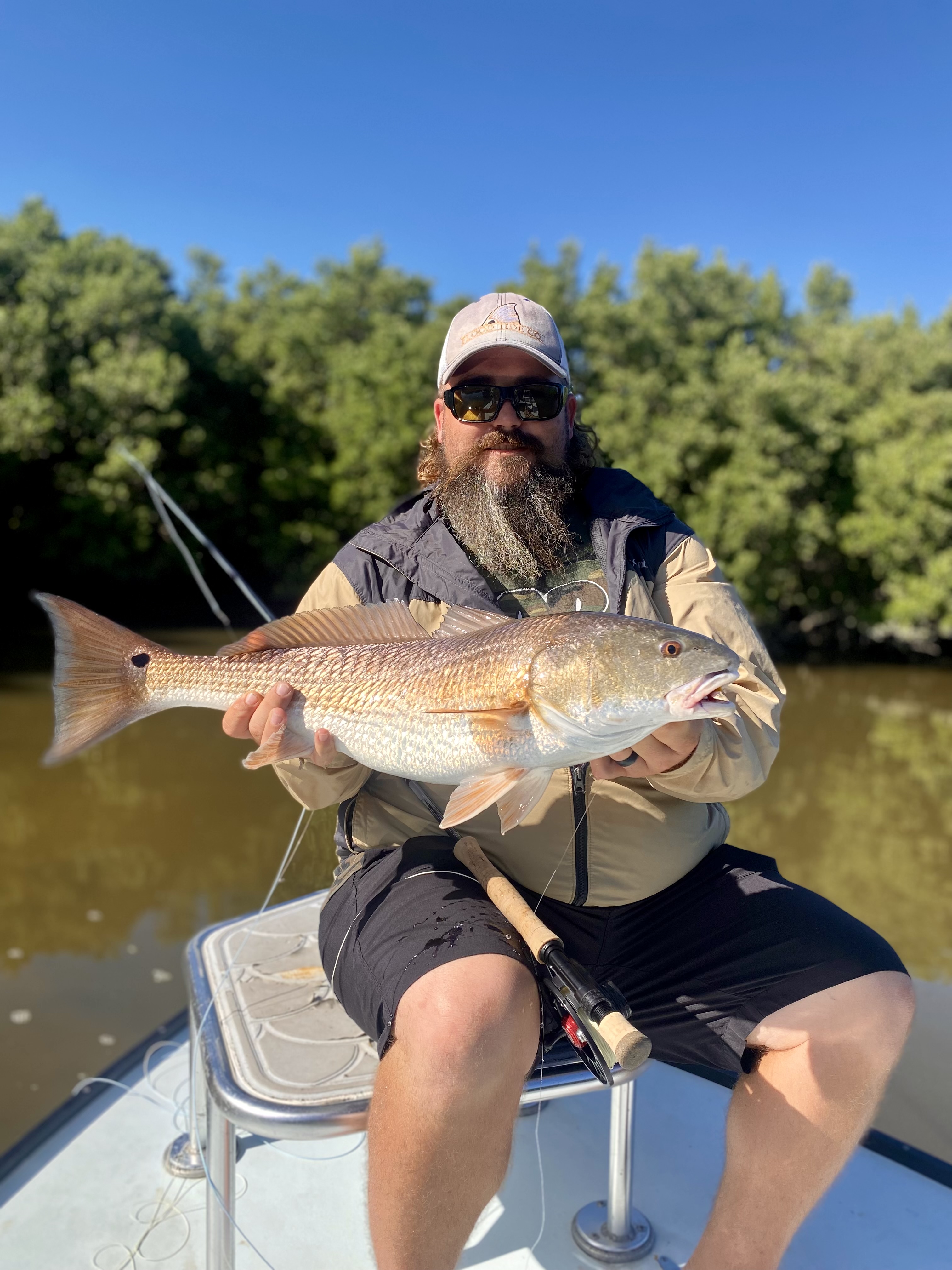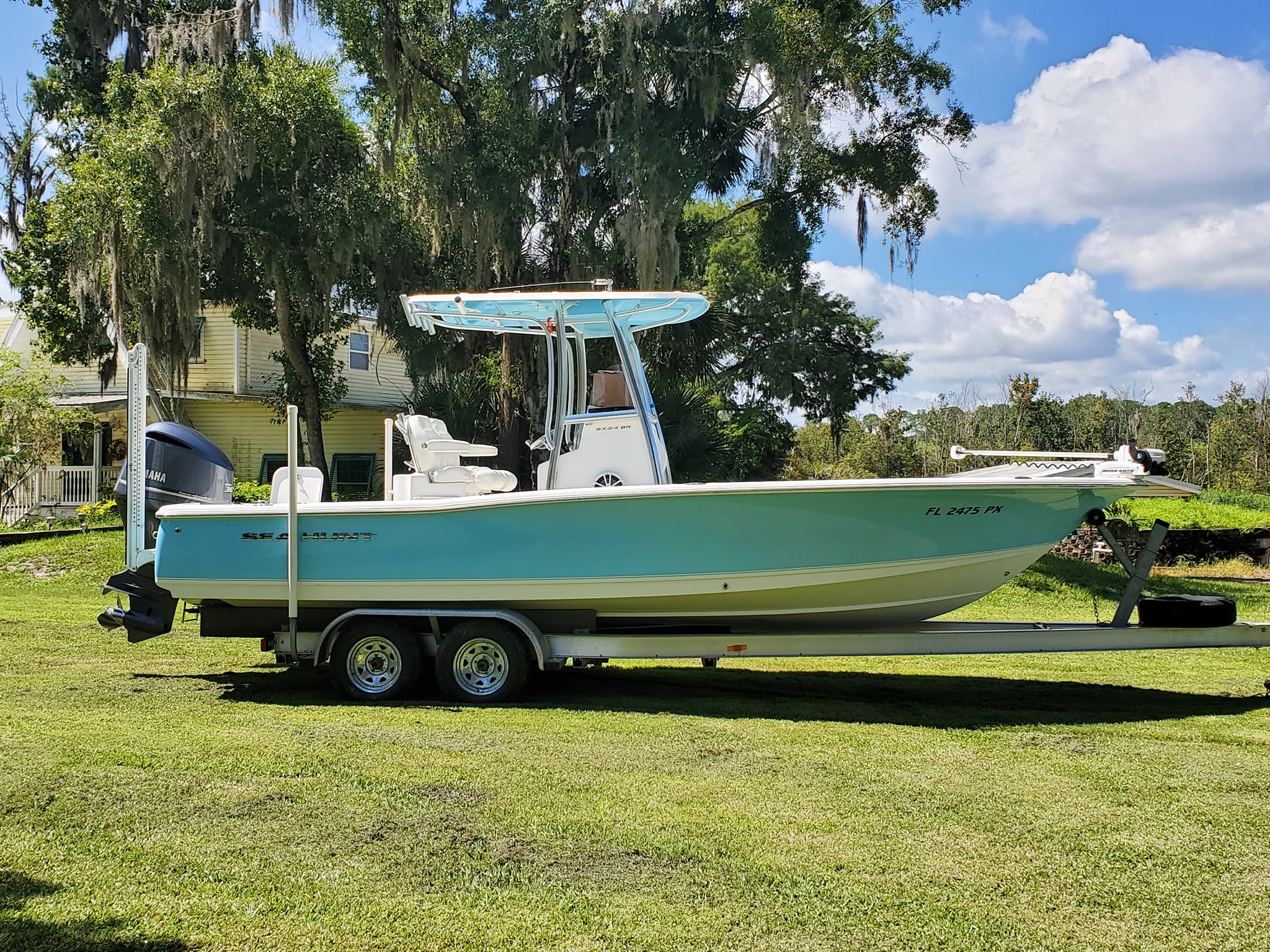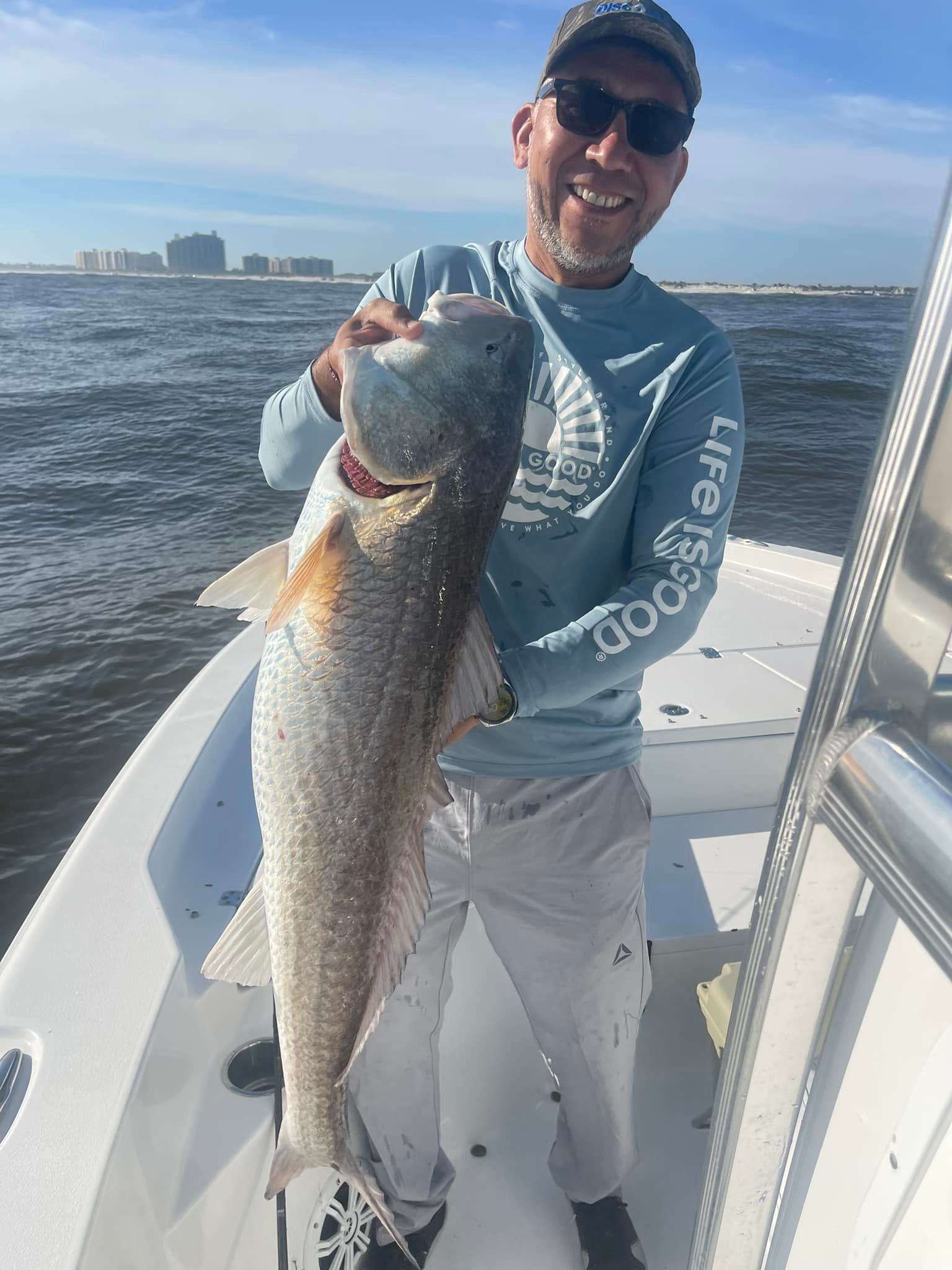Inshore, River, Flats in Wilmington Island
Inshore Fishing Trip
Inshore, Flats Fishing in Pineland
Fly Fishing Pineland
Inshore Fishing in Mount Pleasant
Inshore Fishing
Inshore Fishing in Mount Pleasant
Gigging Trip
Inshore Fishing in Mount Pleasant
Inshore Fishing Trip
Inshore Fishing in Mount Pleasant
4-6hr Inshore Trip
Inshore, Nearshore Fishing in Gulf Shores
Inshore/Nearshore 3-5 Hours
Inshore, Flats Fishing in New Smyrna Beach
Inshore Fishing Trip
Kayak Fishing The Flats
We started Captain Experiences to make it easy to book fishing and hunting guides around the world. With over 2,000 Damn Good Guides, our platform makes finding and booking a trip seamless. Head here to check out our trips.
Redfish are the most popular game fish in the Southeast US for good reason: they are basically everywhere. They also don’t care too much about the water, what they eat, underwater structure, or really anything else. Because they thrive in so many areas and eat basically anything that comes under their nose in any part of the water column, you can have some pretty good fun catching redfish just about anywhere in Texas and just about anyhow.
Attison and Jonathan of Captain Experiences recently went on a redfish round-up tour of Texas and tested out all these methods and locations so you don’t have to (while everyone has their own favorites, Attison’s was inshore wade-fishing with a spinning reel and artificial bait in Aransas Pass. Jonathan’s favorite was trolling with golden spoons for freshwater redfish in Calaveras Lake outside of San Antonio). So pick your poison and mix and match between fishing type, method, and location below for your ideal Texas redfish trip.
Where to Fish for Redfish

Fishing for Redfish Inshore
Inshore fishing is what people typically think of when they think red fishing in Texas. Picture huge flats with some grasses on the bottom and potholes where the redfish will hang out, large mangrove islands where the redfish might catch the current just right to hang out on one end of the island and wait for food, or marshy areas where the redfish might relax around openings in the marsh to catch a snack on the way in or out. Knowing the tide can be critical to flats fishing, and making sure you have a boat with a shallow enough draft is necessary. You can throw out a drift sock and cast off the boat, or (Attison’s favorite) hop out of the boat and stalk your prey on foot.
Fishing for Redfish from the Beach
Beach fishing for redfish can be awesome, and there are often redfish hanging out in the surf. The challenge here is that because you are not relying on sight and because so many other things might be lurking in the same area, its hard to predict what might end up hooked to the other end of your line. Most people fishing on the beach use a casting net to catch bait in the surf and then use that same bait to fish. This is fine because redfish will be happy to eat whatever you catch…but so will many other fish. Make sure your tackle and line will be able to stand up to whatever takes your bait, even if it’s a big shark. Fishing on the beach for redfish is best done when they are running, especially in the fall, for the best chance of hooking up a bull redfish.
Jetty Fishing for Redfish
Whether you are using a boat (be careful of the rough surf around the jetties: see Haulover Inlet) or just walking out, jetty fishing can be a great way to catch some monster fish without having to travel far. Assuming the weather is good feel free to walk down the jetty and cast off it, but there are a lot of situations in which we recommend a boat for easier access (just take the South Padre Island jetty as an example - one side is accessible right in town, but to get to the other without a boat you’d have to drive an hour and then walk a few miles - much easier to boat).
The expert advice here is to stick close to the rocks as that is where the true monsters will be - the structure congregates the fish and that’s where you’ll catch the upper-slot and beyond redfish. Jetties are a magnet for fish, and the Texas coast is dotted with them. You’ll find all kinds of sport fish at the jetty, but jetty fishing for redfish is the most popular during the bull run in the Fall.
Fishing for Redfish on Offshore Structure
When snapper limits get in your way or you’re just looking for a fun light-tackle day at the rig, switch up your tactics and start casting lures towards the rig in the top to middle of the water column. Similar to the jetties, you’ll often get hooked up to some real big redfish that are attracted to the structure. Redfish only leave the coast after they reach maturity at three years, and by that time they are already nearing 10 pounds. Just be careful here - you can catch all the reds you want in federal waters but you can’t keep any, and since you’re out at a rig you’re likely too far out (and most of the fish you’ll find out here are actually big females, aka big egg-layers, so its best to release anyways for the health of the fishery). You’ll find the redfish out to even 300 feet of water.
Freshwater Fishing for Redfish on a Lake
Yes, you can catch freshwater redfish in Texas. I’ll spare you the long writeup and just say that we can confirm they get just as hefty and fight just as hard as their saltwater cousins. They’re stocked every year, and are just a short drive from San Antonio. Read about the Captain Experiences trip down to Calaveras Lake here.

How to Fish for Redfish in Texas

Throwing Bait for Redfish
No matter what style of fishing you’re doing, your goal is to have your lure match what the fish are eating, and there is no better way to have a realistic lure than to throw a live fish at the end of it. Give the fish a natural presentation, and he is sure to bite. What type of bait is available will depend based on time of year and location but the best advice we can give here is to try to have a few different baits in the livewell to make sure you have what the fish are feeling - you don’t want to handcuff yourself to a bait that isn’t working.
Throwing Popping Corks with Shrimp for Redfish
A popping cork is ideal when the fish are acting particularly lethargic. When the cork pops in the water it creates a slurping sound, and this gets the fish interested. The shrimp-tipped jig is the icing on the cake, and the redfish can’t resist the smell. This one-two punch is a tried and true classic for catching reds. Once the cork goes underwater, you know you’ve been bit and its time to set the hook.
Bottom Fishing / Jigging for Redfish
This is your go-to for jetty fishing. Keep the boat about 15-20 feet from the rocks and work the jig (with bait or without) a foot or so from the bottom. Shrimp can work well here as can metal jigs. Our advice is to stick with braided line - you never know if you’re going to hook up to something big, and it never hurts to be prepared.
Throwing Artificials and Soft Plastics for Redfish
Here your options are nearly endless. Take advantage of the fact that redfish are not picky eaters and find what works best for you based on the conditions (location, salinity, temperature, time of day, depth, etc.). A lot of anglers will opt for scented lures with the thought that redfish do often rely on their smell to eat, but everyone has their own preferred lure. Whether you want to use soft plastics, twitch baits, swimbaits, topwaters, and even hard plastic crankbaits designed with bass in mind, you have a good chance of landing some good redfish.
Trolling for Redfish
Trolling with gold spoons (and casting them) is a tried and true method out on the freshwater lakes that house redfish. A weedless gold spoon at varying depths is often too irresistible to the redfish and they’ll come running towards the vibration of the spoon and the flickering light it sends off in each direction as it spins.
Fly Fishing for Redfish / Sight Fishing for Redfish
Redfish are perfect for sight fishing - because of the shallow water they inhabit they are easy to see (you can either see them tailing, or see the “push” of the water as they swim through), they inhabit the same areas consistently all year-round, and their behavior is more predictable than many other species, not to mention they are not terribly picky eaters. Because redfish can get into the 20-30 lb plus range, you’ll want to use a saltwater reel and a 9- or 10-weight rod, and because the water is often a little murky where redfish like to swim you’ll need a lure large and bright enough for them to see. You’ll also need to be wary of the wind - it may seem too obvious to say but the wind on the flats by the Gulf will be significantly heavier than in your local trout stream - plan accordingly.

What Cities to Fish for Redfish in Texas

Galveston Redfish Fishing
Galveston is the most popular fishing spot in Texas, and for good reason - it is the closest you can get to saltwater fishing in Houston and has the biggest bay complex in Texas. The Galveston Bay Complex, which combines Trinity Bay, East Bay, and West Bay, offers more concentrated inshore fishing than anywhere else along the Texas coast. It also offers the greatest confluence of guides, and is a great place to start if you’re local to Houston or want to get the family out.
Port O’Connor Redfish Fishing
Port O’Connor is known to be some of the best redfish fishing in the state of Texas. From Port O’Connor you have a few options, and all of them are great: Head into Matagorda Bay, fish the mangroves just south of the marina, or fish the jetty for bull reds. Given the relative remoteness of Port O’Connor, you’ll find awesome action a 5 minute boat ride from the marina.
Port Aransas Redfish Fishing / Aransas Pass Redfish Fishing / Rockport Redfish Fishing
These three areas congregated just north of the Corpus Christi Bay are usually thought of as a vacation destination (looking at you Port Aransas), but don’t be surprised if you find some great inshore redfish action. The area north of Aransas Pass isn’t called Redfish Bay for no reason. Head up closer to Rockport and you’ll be able to prowl not only Copano Bay and Aransas Bay but also the marshes of Matagorda. And obviously redfish fishing the Corpus Christi Bay is a great option as well.
Baffin Bay Redfish Fishing
Head a little south of the Corpus Christi Bay and you’ll make your way to the Baffin Bay Complex, one of the best fisheries in Texas. The remoteness here is key - private land on both sides of the Bay mean it is inaccessible unless you take the trek by boat from Corpus. We recommend wade fishing for redfish (and speckled trout) here.
Port Mansfield Redfish Fishing
As you head south down the Laguna Madre and pass the Saltillo Flats, you’ll reach Port Mansfield, one of the most remote options on this list. Port Mansfield is a pure fishing town with not much else going on, and you’ll be heading there just to fish the upper section of the Lower Laguna Madre. You’ll have so many untouched marshes to choose from you won’t know where to start.
Port Isabel Redfish Fishing / South Padre Island Redfish Fishing
The furthest you can go without hitting Mexico, from Port Isabel you’ll either hit the jetties or head north into the Lower Laguna Madre and patrol the grass flats for redfish. Never more than 2-4 feet deep, you’ll see the wildlife running before the boat and have a blast drift fishing.
San Antonio Redfish Fishing
And last but not least, the unique freshwater option on the list. Texas Parks and Wildlife stock two lakes in Texas with redfish every year: Calaveras Lake and Victor Braunig Lake, both near San Antonio. If you’re in the Austin or San Antonio area or are looking to try something different, we can promise these fish are one hell of a time to catch.
Attison Barnes
Updated on July 31, 2023

July 1, 2024

June 28, 2023

April 26, 2022

October 26, 2020

March 8, 2022
Related Articles
March 31, 2023
June 12, 2024
Featured Locations
- Fishing Charters Near Me
- Austin Fishing Guides
- Biloxi Fishing Charters
- Bradenton Fishing Charters
- Cabo San Lucas Fishing Charters
- Cancun Fishing Charters
- Cape Coral Fishing Charters
- Charleston Fishing Charters
- Clearwater Fishing Charters
- Corpus Christi Fishing Charters
- Crystal River Fishing Charters
- Dauphin Island Fishing Charters
- Daytona Beach Fishing Charters
- Destin Fishing Charters
- Fort Lauderdale Fishing Charters
- Fort Myers Fishing Charters
- Fort Walton Beach Fishing Charters
- Galveston Fishing Charters
- Gulf Shores Fishing Charters
- Hatteras Fishing Charters
- Hilton Head Fishing Charters
- Islamorada Fishing Charters
- Jacksonville Fishing Charters
- Jupiter Fishing Charters
- Key Largo Fishing Charters
- Key West Fishing Charters
- Kona Fishing Charters
- Lakeside Marblehead Fishing Charters
- Marathon Fishing Charters
- Marco Island Fishing Charters
- Miami Fishing Charters
- Montauk Fishing Charters
- Morehead City Fishing Charters
- Naples Fishing Charters
- New Orleans Fishing Charters
- New Smyrna Beach Fishing Charters
- Ocean City Fishing Charters
- Orange Beach Fishing Charters
- Panama City Beach Fishing Charters
- Pensacola Fishing Charters
- Pompano Beach Fishing Charters
- Port Aransas Fishing Charters
- Port Orange Fishing Charters
- Rockport Fishing Charters
- San Diego Fishing Charters
- San Juan Fishing Charters
- Sarasota Fishing Charters
- South Padre Island Fishing Charters
- St. Augustine Fishing Charters
- St. Petersburg Fishing Charters
- Tampa Fishing Charters
- Tarpon Springs Fishing Charters
- Venice Fishing Charters
- Virginia Beach Fishing Charters
- West Palm Beach Fishing Charters
- Wilmington Fishing Charters
- Wrightsville Beach Fishing Charters































